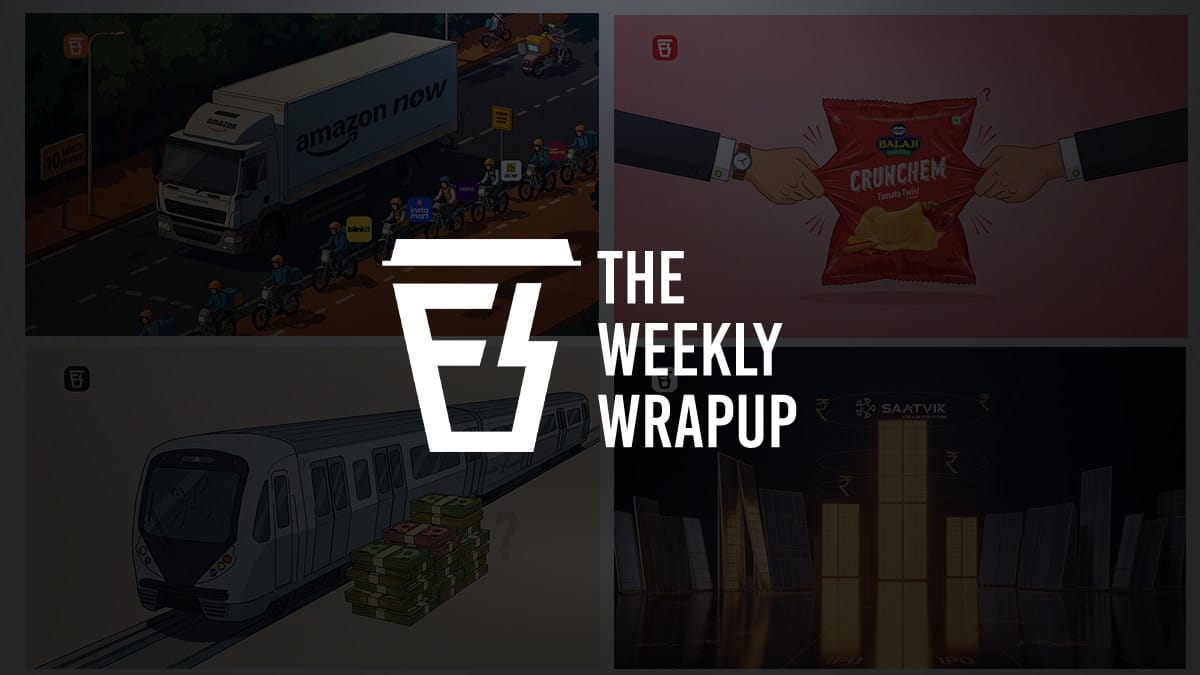Saatvik Green Energy IPO, Balaji Wafers’ stake sale, Bengaluru’s pricey metro and more…

In this week’s wrapup, we break down why buybacks may not always be the magic pill for shareholders, the economics of minting the humble ₹1 coin, why Amazon showed up late to the quick commerce party, Bengaluru’s expensive metro fares, and why FMCG giants are lining up for a bite of Balaji Wafers.
And in this week’s Markets edition, we dive into the Saatvik Green Energy IPO — how its expansion and order book are powering growth, as well as the risks that one needs to weigh before betting on this solar player. Click here to read the full story.
But here’s a quick sidenote before we begin. In just a few days, GST on insurance premiums will be gone — making policies cheaper. And while most people will scramble to make sense of it, you can walk in prepared.
Join our 2-day masterclass where we break down health and life insurance in simple, actionable steps. You’ll know exactly what to buy, how much cover you should choose, and what traps to avoid.
👉🏽 Click here to reserve your spot today. Only few seats left — and this is your last chance to get clarity before the change.
With that out of the way, let’s recap what we wrote this week.
Are buybacks these days just kicking the can down the road?
Buybacks are supposed to signal confidence. A company spends thousands of crores to mop up its own shares, and investors feel reassured as earnings per share tick up, the stock price finds a floor, and everyone applauds.
But what happens when this quick fix comes at the cost of tomorrow’s battles? For instance, Infosys recently rolled out an ₹18,000 crore buyback, even as it stares at the twin challenges of AI disruption and looming tariff risks in the US. So the question is: should companies be splurging on stock optics, or saving for invention and insurance?
That’s something we try to answer in our Monday’s newsletter.
Why India needs a coin replacement policy
UPI may dominate our payments, but one tiny denomination refuses to fade away. The ₹1 coin. The irony, though, is that it costs more than a rupee to mint every single one. That means the government loses money on every coin it produces, and yet nearly 40% of all coins in circulation today are ₹1.
So why does the government tolerate this loss? Because for millions of Indians, from street vendors to daily wage earners, the coin still makes everyday life possible. And scrapping it would create chaos.
Does that mean India is stuck footing the bill forever, or could smarter policies cut costs without hurting trust?
Our Tuesday’s story explores how countries like Canada and Malaysia dealt with their smallest coins, and what India could learn from them.
Why is Amazon late to the quick commerce party?
Zomato’s Blinkit and Swiggy’s Instamart have been duking it out for years, burning cash to grab market share. Dunzo and JioMart Express already collapsed under the pressure. And just when the dust seems to be settling, Amazon has walked into the ring with its own 10-minute delivery play.
On the surface, the timing looks odd. But dig deeper and it starts to make sense. Post-pandemic losses, regulatory hurdles on foreign e-commerce, and an early chance to learn from others’ mistakes may explain Amazon’s strategy. And now, with its massive user base and deep pockets, the company believes it can still tilt the game.
But can a late-mover really win in a space where rivals are bleeding money? Check out the Wednesday’s newsletter to find out more.
Why Bengaluru has the most expensive metro
This February, lakhs of Bengaluru commuters swiped their metro cards and got a shock. Fares had jumped by almost 70%, making Namma Metro the priciest in India. BMRCL said costs had soared, but a closer look showed the numbers didn’t add up neatly. Because on a per-kilometre basis, expenses had risen far less than the authority claimed, and ridership had actually surged.
So why the steep hike?
Well, the truth lies in Bengaluru’s metro finances that are filled with massive debts, delays that balloon project costs, and a funding structure heavily dependent on a cash-strapped state government.
We tell you about these in detail, and if fare hikes can really make it sustainable in our Thursday story here.
FMCG giants want some chips at Balaji Wafers
From a Rajkot cinema canteen in the 1970s to a ₹40,000 crore valuation today, Balaji Wafers has quietly built an empire.
And with 65% market share in states like Gujarat and Maharashtra, a sacred commitment to ₹5/₹10 price points, and a distribution muscle that reaches 4.5 lakh kiranas, it’s little wonder that FMCG giants and private equity firms want a stake.
But scaling a regional champion into a national brand isn’t easy. It risks eroding the very authenticity that built Balaji’s moat. Yet, with India’s snack market booming, Balaji might just be the last great challenger standing against global titans.
We break down how Balaji cracked this market and what's next in our Friday newsletter.
Liked this wrapup?
